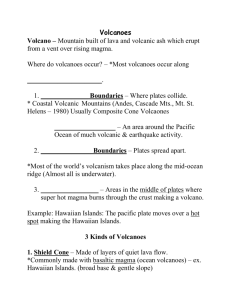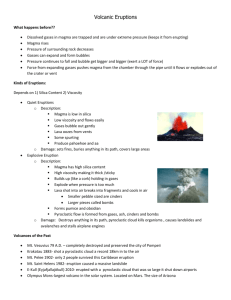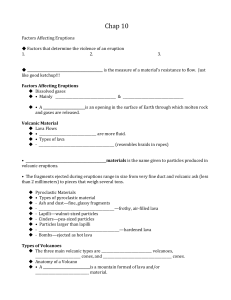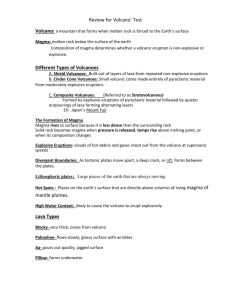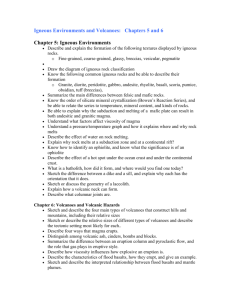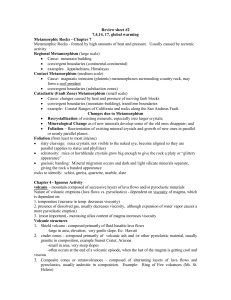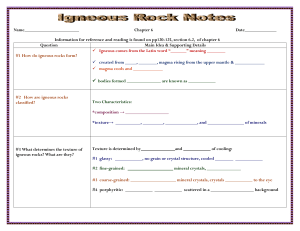Textbook Reading Assignments for the Igneous Processes and
advertisement
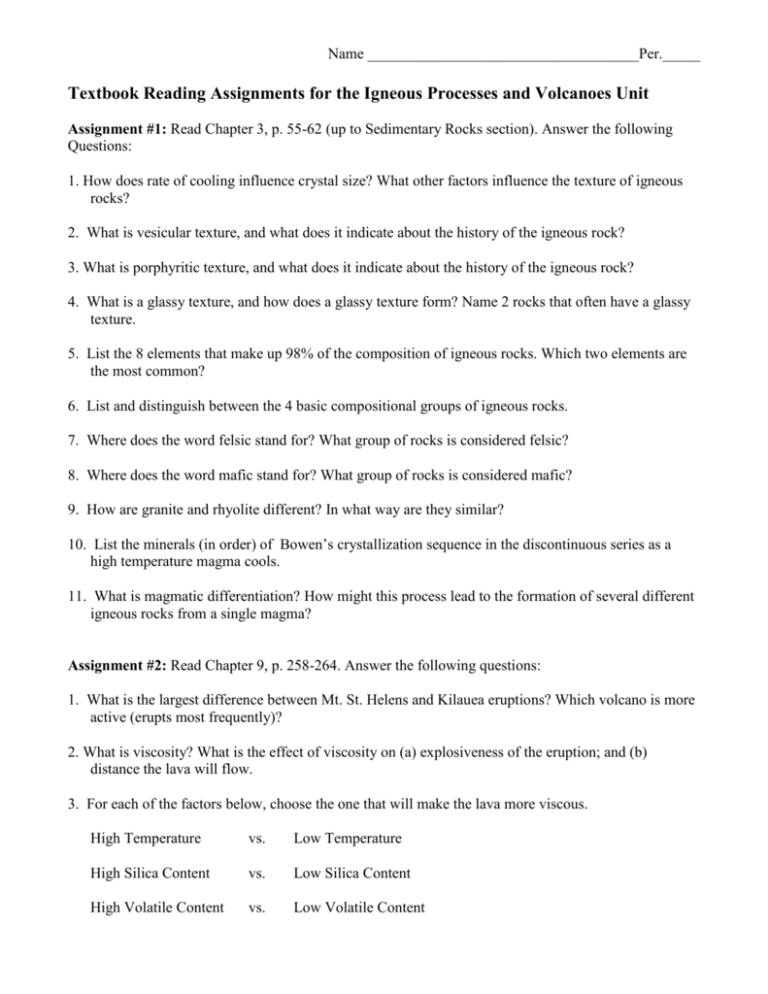
Name ____________________________________Per._____ Textbook Reading Assignments for the Igneous Processes and Volcanoes Unit Assignment #1: Read Chapter 3, p. 55-62 (up to Sedimentary Rocks section). Answer the following Questions: 1. How does rate of cooling influence crystal size? What other factors influence the texture of igneous rocks? 2. What is vesicular texture, and what does it indicate about the history of the igneous rock? 3. What is porphyritic texture, and what does it indicate about the history of the igneous rock? 4. What is a glassy texture, and how does a glassy texture form? Name 2 rocks that often have a glassy texture. 5. List the 8 elements that make up 98% of the composition of igneous rocks. Which two elements are the most common? 6. List and distinguish between the 4 basic compositional groups of igneous rocks. 7. Where does the word felsic stand for? What group of rocks is considered felsic? 8. Where does the word mafic stand for? What group of rocks is considered mafic? 9. How are granite and rhyolite different? In what way are they similar? 10. List the minerals (in order) of Bowen’s crystallization sequence in the discontinuous series as a high temperature magma cools. 11. What is magmatic differentiation? How might this process lead to the formation of several different igneous rocks from a single magma? Assignment #2: Read Chapter 9, p. 258-264. Answer the following questions: 1. What is the largest difference between Mt. St. Helens and Kilauea eruptions? Which volcano is more active (erupts most frequently)? 2. What is viscosity? What is the effect of viscosity on (a) explosiveness of the eruption; and (b) distance the lava will flow. 3. For each of the factors below, choose the one that will make the lava more viscous. High Temperature vs. Low Temperature High Silica Content vs. Low Silica Content High Volatile Content vs. Low Volatile Content 4. What is the starting composition of most magma? 5. What happens to basaltic magma under the crust that ultimately changes the composition of what is erupted? 6. What triggers a Hawaiian-type eruption? 7. What is the role of volatiles in the explosiveness of an eruption? Why are high silica magmas much more explosive than low silica magmas? 8. Describe pahoehoe and aa lava flows. 9. How do lava tubes form? What composition of lava is most likely going to make a lava tube? 10. List the main gases released during a volcanic eruption. What role do gases play in an eruption? 11. How do volcanic bombs differ from blocks of pyroclastic debris? 12. What is scoria? How is scoria different from pumice? Assignment #3: Read p. 265-276, up to Intrusive Igneous Activity. Answer the following questions: 1. Distinguish between a volcanic crater and a caldera. 2. Compare and contrast the three main types of volcanoes (consider size, composition, shape, and eruptive style). Name a prominent volcano for each of the three types. A chart may help you organize this information. 3. Briefly compare the eruptions fo Kilauea and Paricutin. 4. Describe the nature of a pyroclastic flow. 5. Contrast the destruction of Pompeii (see box 9.1) with the destruction of St. Pierre. Discuss time frame, volcanic material, and nature of destruction. A chart might help you. 6. What is a lahar? 7. Describe the formation of Crater Lake. Compare it to the formation of a caldera found on shield volcanoes, such as Kilauea. 8. What is a pyroclastic flow? Extensive pyroclastic flows are associated with which volcanic structure? 9. How do the eruptions that created the Columbia Plateau differ from eruptions that create large composite cones? 10. What is Shiprock, NM, and how did it form? Assignment #4: Read p. 276-291, and answer the following questions: 1. Describe each of the four basic intrusive features; dike, sill, batholith and laccolith. Classify each one as either massive or tabular, and as either concordant or discordant (as a general rule). 2. What is the geothermal gradient? 3. Describe the three ways that solid rock in the upper mantle and crust may melt to become magma. 4. In which two settings does decompression melting occur? 5. What does the addition of volatiles do to the melting temperature of rock? At which type of plate boundary is this especially important? 6. What is partial melting? Hoes does the composition of a melt produced by partial melting compare with the composition of the parent rock? 7. Why do volcanoes in the Ring of Fire generally produce violent eruptions? 8. How is magma generated along convergent plate boundaries? 9. What rock type is produced at divergent plate boundaries? What causes rock to melt in these regions? 10. What is the source of magma for intraplate volcanism? 11. At which type of plate boundary is the greatest quantity of magma generated? 12. Describe 4 natural hazards associated with volcanoes. 13. What are the 4 changes in a volcanic area that are monitored in order to detect the migration of magma?
